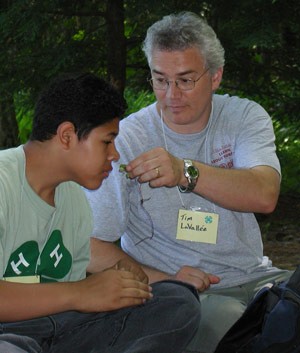The young people board the van in the middle of a loud, congested neighborhood. As they ride, they watch the scenery gradually change from factories and apartment buildings to fields and forests. They arrive at their destination, a peaceful spot deep in the woods unlike any place they’ve ever been before. They spend the day in the quiet forest with a couple of instructors learning, exploring, playing, and working together.
This summer, a day like this will provide a memorable experience for hundreds of young people. And for some, it will be a day that will change their lives.
The program is called Learn About Forests (LAF), and it’s the brainchild of Anthony Sanchez, co-founder and director of the Eagle Eye Institute in Somerville, Massachusetts. Since 1992, this program has introduced more than 3,000 urban children to the natural world.
Sanchez knows from his own experience the power that this world has to transform lives. He grew up in New York City, where he had almost no contact with nature. “Caring for the environment should be everyone’s concern,” he says, “but how can you be concerned for something you know nothing about? How can you aspire to something you have never experienced?” Children growing up in the city, he explains, have very little exposure to the forest or other aspects of the natural world. They have no knowledge of how that world affects theirs, and they are unaware of the opportunities the forest holds for them for recreation, personal growth, or even careers.
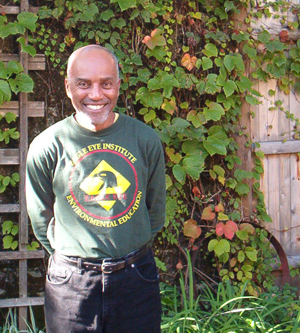
Anthony Sanchez, co-founder and director of LAF
At the age of 13, Sanchez got into trouble and was sent to an institution in upstate New York. There, for the first time, he experienced the things rural residents take for granted, like skating on a frozen pond, riding horses, and hiking through the woods.
“The importance of my first experience with the outdoors was that it led me to say yes the next time,” said Sanchez. “That is a basis for Learn About Forests – if they have one experience, maybe they’ll be more likely to say yes when another opportunity arises.”
Sanchez’s next opportunity came when he was a student at Hampshire College in Amherst, Massachusetts. He spent many weekends hiking through the nearby Holyoke Range. It was on one of these hikes, while watching an eagle soar overhead, that he received the inspiration to create an environmental institute for urban children. Many years elapsed, however, before his idea became reality. “I was like a small hemlock tree in the understory of the forest, waiting for an opening up above so I could grow.”
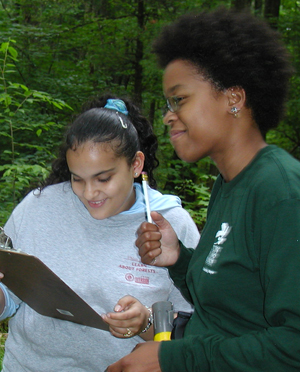
Taking tree measurements and checking the math
That opening came when he met his partner in life, MaJa Kietzke, after she returned from her service as a Peace Corps volunteer in Barbados, and together they started to build the dream. In 1990 they purchased a parcel of forested land in Peru, Massachusetts. Two years later Sanchez and Kietzke loaded up their van with a group of teenagers from a Somerville program for children of alcoholics and drug abusers and drove them to Peru. There they were met by extension forester David Kittredge and state forester Ann Marie Laud, who were ready to help introduce the group to the forest.
“We learned as we went along,” said Sanchez, “and the land taught us the elements we needed for success.” There was a long road into the property, and hiking in helped the children adjust slowly to this strange new environment. Along the way, Kittredge and Laud pointed out red efts and lady’s slippers, which got the kids’ curiosity going. At the end of the road, there was a natural opening, which became their headquarters for the day, their eagle’s nest. The foresters each taught a lesson: Kittredge took them to a nearby beaver pond where they used 100-foot tape measures to find the beaver stump farthest from the dam; and Laud led a scavenger hunt for signs of wildlife within a quarter-acre plot the kids measured out and flagged. Then they all worked together clearing brush from the road and the eagle’s nest. Together, they built a fire, cooked hot dogs, and played games. The children were at first reluctant to venture far from the road or the clearing, and the bugs and the dirt kept distracting them. By the end of the day, however, they were turning over rocks and logs to see what was beneath them and ignoring the mosquitoes like seasoned woodsmen.
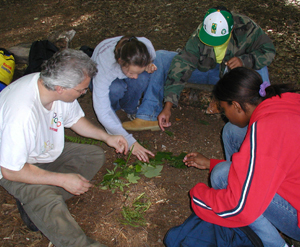
Inspecting tree leaves with instructor Tim LaVallee
of the Tsongas Industrial History Center at the University
of Massachusetts-Lowell
What Sanchez remembers most about the day was the ride home. It was after 10 P.M. when they returned to Somerville; they should have been exhausted, but the children were still energized by their experience. “We were laughing, talking, and singing together. It was a powerful experience. It was as though we had stumbled upon success.”
They ran two LAF programs that first summer, four the next, and continued to build and refine the program each succeeding year. They understood right away how important it was that the instructors be professionals who worked outdoors: foresters, soil scientists, wildlife biologists, and naturalists. It was pivotal to the experience to have people there who could demonstrate skills they use in their jobs and who could answer the questions the kids threw at them. More important, however, was the obvious love the instructors had for the outdoors and for their jobs. “We’ve seen it over and over again,” said Sanchez. “When the youth see the passion in the instructor’s eyes, they know that it is real, and they respond.”
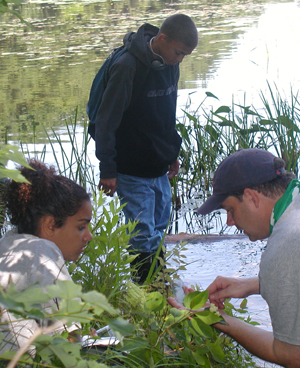
Exploring pond life
As the program grew, the founders began to enlist “champions,” organizations willing to coordinate LAF programs for their own communities. The University of Massachusetts Extension 4-H program has been an LAF champion since 2001, and Rita Renee Toll-Dubois is one of three 4-H staffers who lead 10 programs each summer, with youths from Boston, Lowell, Worcester, and Holyoke. Part of her job is to help the instructors relate to their students and to help the young people understand the instructors. “It’s not only about learning,” she says. “It’s also about the development of a community – that’s what it takes to make a difference.”
Two instructors and a dozen young people from ages 10 to 18 will participate in a typical LAF day. The small group size is very important, says Toll-Dubois. “These children are used to being one of 30 in a class where they can hide in back and not have to participate. Most of them have no adult mentors, and few adults spend time with them.” It’s powerful when the instructors make a connection to each one and know everybody by name, Toll-Dubois said.
Instructors provide two hands-on lessons that involve the children directly in the learning process. At their orientation, this point is driven home for the instructors when they’re told the tale of the soil scientist who carried his tools into the woods, dug his own soil pit, and then began describing the soil, only to be met with blank stares and disinterested looks. The next time, he let the kids carry the shovels and dig the hole, and then he let them tell him what they saw in the soil. The children fought for their turn with the shovel and eagerly examined handfuls of dirt.
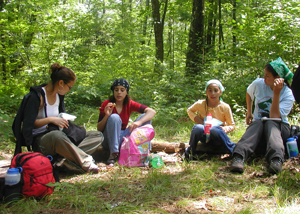
Lunch at their “eagle’s nest.”
Each LAF day includes what they call a stewardship project. Past projects include repairing an eroded hiking trail, installing a culvert in a stream, and building brush piles for wildlife habitat. This is not make-work; they are meaningful projects within the children’s skill levels that will produce visible results. The staff and instructors work alongside the students on these projects, but it is the kids who are given the responsibility for planning and coordinating the job.
Although the time in the woods is short, it is meaningful. “What can happen in a day?” asks Sanchez. “Think back on your own life and on the pivotal experiences with nature that made you what you are. Those transformational experiences can happen in a moment.”
Diana Payne, a young woman who last summer worked for Toll-Dubois on LAF programs, knows from her own experience that the program can change people’s lives. She was 13 when she first participated, and at the beginning she was scared of the forest and bothered by all the bugs.
“As the day went on, though, I began to feel a sense of calmness that I had never experienced in the city,” said Payne. “And the more I went, the more I loved it. I have a deeper appreciation of nature now, and I look forward to going back again.”


